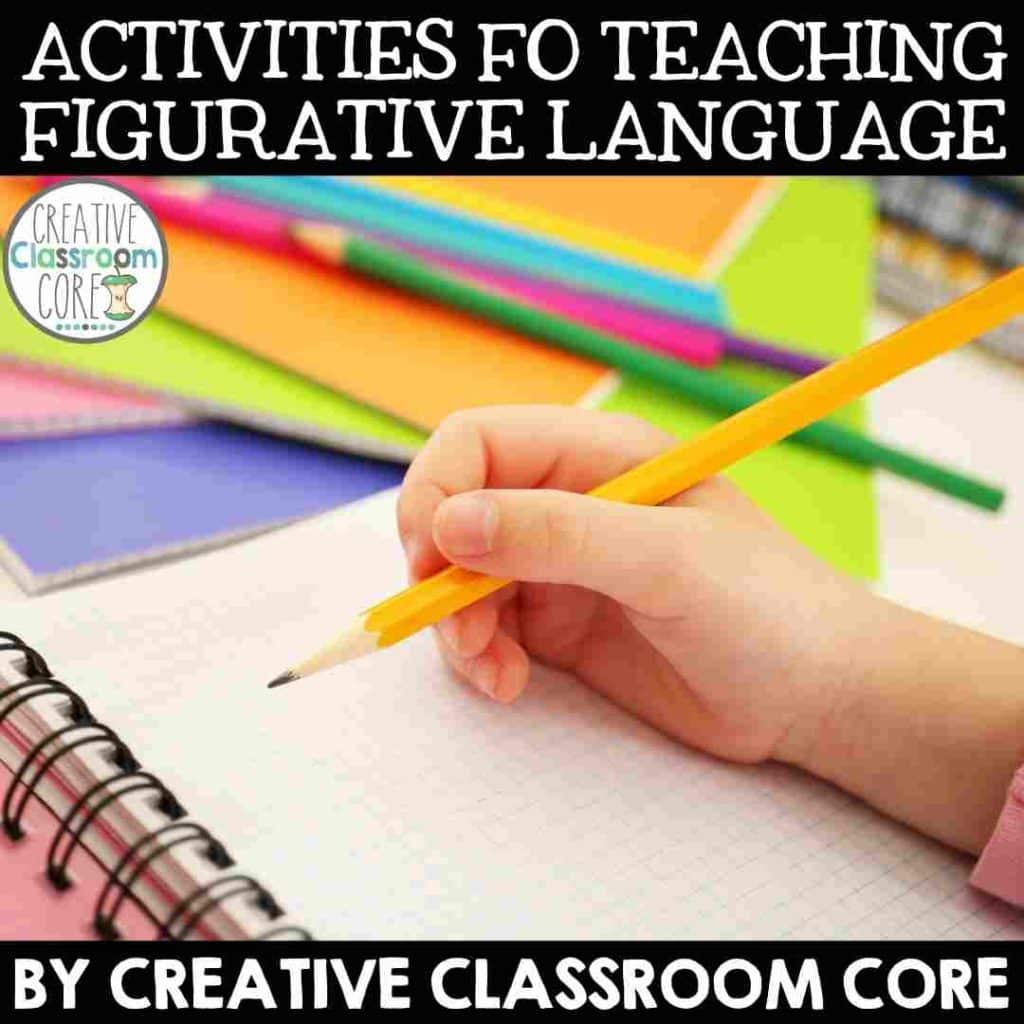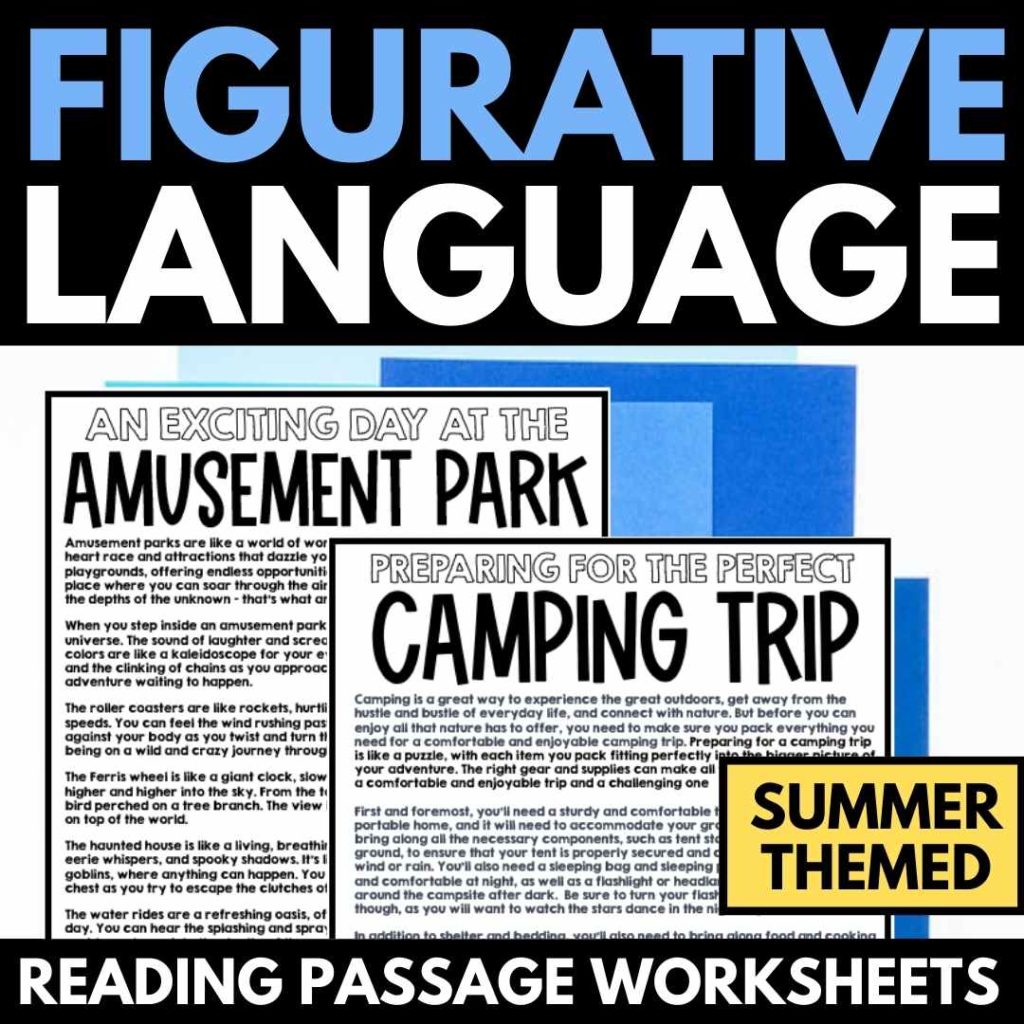5 tips for teaching figurative language
By MARISSA DESPINS Updated Oct 16, 2023
Teaching figurative language can be both enjoyable and challenging for educators and students alike. However, with the right approach, it can be an engaging and exciting experience for everyone involved.
If you are feeling overwhelmed by the task of teaching figurative language, fear not. The key is to help your students understand the practicality and importance of using figurative language. Students often question the relevance of what they are learning in school. However, in the case of figurative language, they often use it in their everyday conversations without even realizing it. From movie quotes to song lyrics to commercials, figurative language is all around us.
Looking for some no-prep figurative language activities that you can print and use right away with your learners? Click on the link or button below to see all of the activities for teaching figurative language in my TPT shop!
Tips for teaching figurative language
It is crucial to teach students how to understand and appreciate the purpose and application of figurative language. By doing so, we can help them develop critical thinking skills and improve their writing and communication abilities. Ultimately, teaching figurative language will deepen their appreciation for the power and beauty of language. Read on for some helpful tips on how to make teaching figurative language a success in your classroom.
What is figurative language AND WHY SHOULD I TEACH IT?
Figurative language is a powerful tool used to convey meanings beyond the literal interpretation of words. Its purpose is to make abstract concepts more tangible and relatable to an audience. It does this by infusing them with implications, imagery, emotions, and connotations.
In essence, figurative language can be seen as a creative approach to expressing meaning, akin to the special effects of the written word. It is employed by a wide range of communicators, from authors to advertisers, who rely on its nuanced meanings to help convey ideas. They do this by encouraging people to draw comparisons, make inferences, and uncover deeper messages.
By teaching figurative language, students develop skills in interpretation, critical thinking, and inference. This enables them to establish a deeper understanding of the text and connect it with their experiences. It offers them more creative and impactful ways to express their ideas, not just in literature or English class but in everyday language too. The expansion of their figurative language toolbox provides students with a more concrete understanding of the language they use every day.
Tips for teaching figurative language
When it comes to teaching ELA, there are various approaches to take. However, some methods are more effective than others. If you’re looking for ways to teach figurative language in a fun and engaging way, you’ve come to the right place.
TIP #1- Scaffold your teaching
Before delving into the literature, it’s important to ensure that students have a solid grasp of the basics of figurative language. While secondary students may already have a foundational understanding, it’s still necessary to scaffold the introduction of more complex uses of language, such as allusions, idioms, personification, and synecdoche. Instead of bombarding students with a long list of complex terms and definitions, it’s best to focus on a few examples at a time. This will prevent students from feeling overwhelmed. Instead, it allows them to gradually build their knowledge and skills.
TIP #2- Use engaging mentor texts
Teaching figurative language in context is crucial. While starting with words and definitions is a good idea, it’s not enough. Students require additional context to grasp how figurative language functions. For a more in-depth analysis, combine the terms and their meanings with diverse examples from literature and poetry.
For a compelling example of figurative language in classic literature, consider exploring our lesson on Teaching The Tell-Tale Heart. This story by Edgar Allan Poe is rich in figurative language and can provide an excellent context for students to understand and analyze literary devices
Engaging mentor texts can sometimes be difficult to find – find some great titles in our guide to Diverse and Inclusive Short Stories for Middle School!
Tip #3- Let Students locate examples
You don’t have to do all the work yourself. Figurative language scavenger hunts are some of my favorite ways for students to independently review! Check out two of my favorite figurative language scavenger hunt activities below. Both are included in my complete Figurative Language Bundle!
⭐Sticky Note Scavenger Hunt Activity: To complete this engaging activity, students read through a variety of short stories (suggested stories are included), write figurative language examples on sticky notes, and stick them to the graphic organizers. Completed templates makes great Interactive Notebook additions!
⭐Short Story Figurative Language Activity: For this activity, students use the 4 included worksheets to help them to identify figurative language examples from 4 classic short stories – “The Gift of the Magi” by O. Henry, “The Necklace” by Guy De Maupassant, “The Most Dangerous Game” by Richard Connell, and “All Summer in a Day” by Ray Bradbury”.
Looking for full text copies of short stories you can use in your classroom? Check out our post on the Very Best Short Stories for Middle School!
Tip #4- Get Creative with Drama
An additional fun way to review figurative language is to have students showcase examples through performance. Divide the class into small groups and assign each group a specific figurative language device. Instruct them to create a short 1-2 minute script that highlights their assigned literary device. Afterwards, challenge the other students to identify which type of figurative language is being used in each performance.
For tips and tricks for incorporating art based activities into your classroom curriculum, check out guide to the Benefits of Arts Integration!
Tip #5- Creative Writing
One of the most exciting ways to engage students with figurative language is to encourage them to use it in their own creative writing. This helps them practice using the language themselves. Also, it allows them to see the impact and power of figurative language in their own writing. There are many different creative writing activities that you can use to help students practice using figurative language.

One activity is to have students create a list of examples and non-examples of figurative language. This can be a fun and engaging way to get students thinking about the different types of figurative language and how they can be used effectively. For example, students could create a list of similes that compare a person to an object or animal. Alternately, they could create a list of metaphors that describe an emotion.
One of my favorite activities is to have students describe an emotion using an extended simile or metaphor. This activity allows students to explore the complex and abstract nature of emotions while also practicing their use of figurative language. For example, students could describe the feeling of happiness as a warm summer day, with the sun shining down and a gentle breeze blowing through the trees. Or they could describe the feeling of sadness as a heavy weight pressing down on their chest, making it hard to breathe.
When designing creative writing activities that use figurative language, it’s important to establish guidelines that meet your students’ learning needs. You can provide prompts and examples to help students get started. Also, you can provide feedback and support as they work on their writing. With the right guidance and support, students will develop a deep understanding and appreciation of the power and beauty of figurative language.
For more fun writing activities to engage your learners, be sure to check out our descriptive writing ideas!
Looking for a complete unit for teaching figurative language?
Check out the Figurative Language bundle available in my TPT shop. It contains over 180 pages of resources with student notes, scavenger hunt activities, and 3 complete short story units! Grab a copy for your learners by clicking here or on the image below.
For more fun activities for teaching figurative language, you won’t want to miss our post on Halloween Figurative Language Activities for Middle School!
Looking for a free resource for teaching figurative language?
Click here or on the image below to download these great figurative language reading passages worksheets! Students read through the included passages and highlight examples of simile, metaphor, hyperbole, onomatopoeia, and personification!
Want to read more about ELA Activities for Upper ELementary and Middle School?
Check out these blog posts!
Things Every ELA Teacher Should Do at the Start of a New School Year
7 Strategies for Teaching Paired Passages
The BEST Short Stories for Middle School
Interested in signing up for my email list?
If you are interested in signing up for my email list, you can do so by clicking on the link below. I periodically send out emails with free resources, teaching tips, and exclusive deals. Signing up will also give you immediate access to some of my best selling Interactive Notebook resources. These include foldable activities, graphic organizers, and other fun activities.












